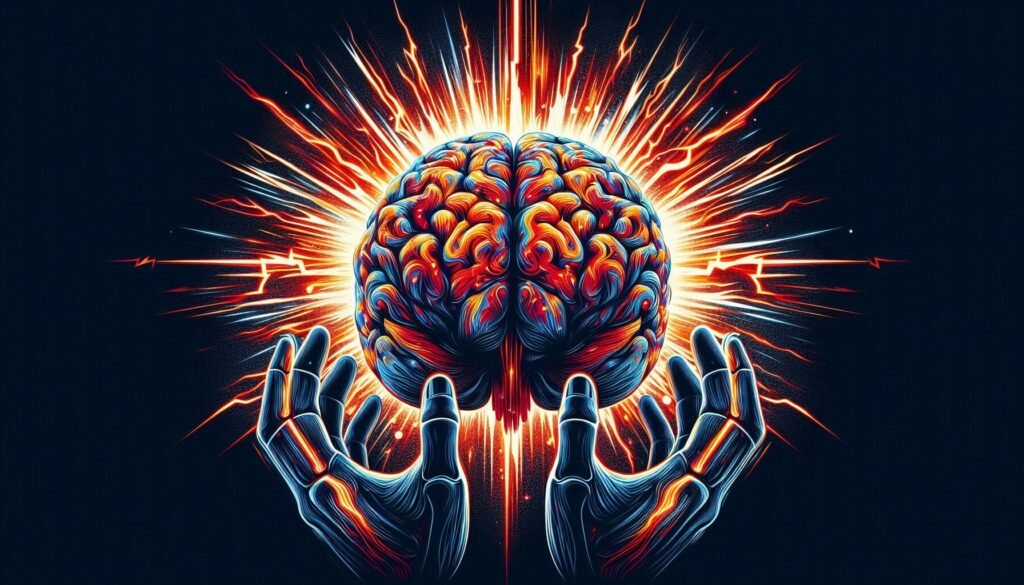Thalamic Pain Syndrome is a complex and often misunderstood condition that can arise following a stroke. It manifests as chronic pain, which can significantly impact the quality of life for those affected. Imagine living with an unrelenting discomfort that seems to have no clear source—a challenge faced by many who develop this syndrome after neurological damage.
The thalamus plays a crucial role in processing sensory information, including pain signals. When it suffers injury, the consequences can be severe and perplexing. Understanding Thalamic Pain Syndrome is essential not only for patients but also for caregivers and healthcare providers seeking effective management strategies.
This blog post will guide you through the intricacies of this syndrome, shedding light on its anatomy, causes, symptoms, diagnosis methods, treatment options, and much more. Whether you’re looking to educate yourself or support someone dealing with Thalamic Pain Syndrome, we’ve got you covered with valuable insights into this challenging condition.

Understanding Thalamic Pain Syndrome: Definition and Overview
Thalamic Pain Syndrome is a type of chronic pain that arises after damage to the thalamus, often due to a stroke. This condition is characterized by sensory abnormalities and persistent discomfort in areas of the body affected by the initial neurological incident.
Patients may experience sensations that are altered or exaggerated, leading to severe pain even when there’s no apparent injury. The thalamus acts as a relay station for sensory signals, so any disruption can significantly affect how these signals are perceived.
“Why Does Ganser Syndrome Cause False Answers?”
Typically emerging weeks or months post-stroke, Thalamic Pain Syndrome doesn’t follow traditional patterns of nerve injury pain. Instead, it presents unique challenges for both patients and healthcare providers in terms of diagnosis and treatment strategies. Understanding this syndrome requires delving into its underlying mechanisms and recognizing its impact on daily life.
Anatomy of the Thalamus: Its Role in Pain Perception
The thalamus is a small, egg-shaped structure located deep within the brain. It acts as a crucial relay station for sensory information. Every sensation, including pain, must pass through this region before reaching higher brain areas.
Within the thalamus are specialized nuclei that process different types of stimuli. For example, some nuclei focus on touch and temperature, while others deal with nociceptive signals—those involved in pain perception.
“How Does Gaucher’s Syndrome Affect Metabolism?”
When these pathways become disrupted due to injury or stroke, the result can be devastating. The brain may misinterpret signals leading to heightened sensitivity or chronic pain states like Thalamic Pain Syndrome. Understanding its anatomy helps illuminate how such conditions develop and why they affect individuals so profoundly.
By comprehending the role of the thalamus in processing sensations, we gain insight into potential treatment avenues for managing complex pain disorders effectively.
Etiology of Thalamic Pain Syndrome: Causes and Risk Factors
Thalamic Pain Syndrome often arises following a stroke that affects the thalamus. This crucial brain region processes sensory information, making it pivotal in pain perception.
Other causes include traumatic brain injuries and tumors affecting the thalamus. In rare cases, multiple sclerosis can also lead to this syndrome. Each of these conditions disrupts normal signaling pathways in the brain.
“What Is Gerstmann Syndrome? Brain Function Guide”
Certain risk factors heighten susceptibility to developing Thalamic Pain Syndrome. Age plays a significant role; older adults are more likely to experience strokes or neurological damage.
Additionally, pre-existing health issues like hypertension and diabetes increase stroke risk. Lifestyle choices such as smoking contribute further to vascular problems, amplifying the risks associated with this complex condition.
Pathophysiology: How Thalamic Damage Leads to Chronic Pain
Thalamic Pain Syndrome arises from damage to the thalamus, a critical relay station for sensory information. Injuries in this area disturb normal pain processing pathways.
When the thalamus is affected, it can lead to abnormal responses to stimuli. This phenomenon occurs because the brain misinterprets signals from damaged nerves, resulting in heightened sensitivity or even spontaneous pain sensations.
“Why Does Harlequin Syndrome Affect Sweating? Expert Guide”
The disruption of descending inhibitory pathways is another factor. These pathways usually help modulate and dampen pain signals sent by peripheral nerves. When compromised, they can no longer effectively control these signals.
As a result, patients may experience an exaggerated perception of pain that doesn’t correlate with any physical injury. Understanding this complex interplay between thalamic function and chronic pain illuminates why Thalamic Pain Syndrome presents unique challenges for treatment and management.
Clinical Presentation: Recognizing the Signs and Symptoms
Thalamic Pain Syndrome often presents with a distinct set of symptoms. Patients typically experience intense, chronic pain following a stroke that affects the thalamus. This pain can be described as burning, aching, or stabbing.
Sensitivity to touch is another hallmark feature. Many individuals report heightened pain responses to stimuli that usually aren’t painful. For instance, light touch may provoke severe discomfort.
“How Does Holt-Oram Syndrome Impact Heart Development?”
Additionally, patients might have difficulty distinguishing between hot and cold sensations due to disrupted sensory pathways.
Emotional distress frequently accompanies these physical symptoms. Anxiety and depression are common in those dealing with chronic pain conditions like Thalamic Pain Syndrome.
Sleep disturbances also occur, further complicating recovery efforts. Recognizing these signs early can lead to timely interventions and improved patient outcomes.
Types of Pain in Thalamic Pain Syndrome: Characteristics and Patterns
Thalamic Pain Syndrome presents a diverse range of pain types, each with distinct characteristics. Patients often experience burning sensations, which can feel intense and unrelenting. This form of pain usually affects one side of the body.
Another common type is allodynia. In this condition, normal stimuli become painful. Simple actions like touching the skin or wearing clothing may provoke discomfort.
“What Causes Hunter Syndrome? Enzyme Deficiency Guide”
Hyperalgesia is also prevalent in these cases. It refers to an exaggerated response to pain stimuli, making even mild discomfort seem severe.
Pain may fluctuate over time as well. Episodes might vary from sharp stabbing pains to dull aching sensations depending on triggers such as stress or fatigue.
Understanding these patterns helps clinicians tailor treatment approaches effectively for individuals suffering from Thalamic Pain Syndrome. Each patient’s experience can be unique, highlighting the need for personalized care strategies.
Diagnostic Criteria: How Thalamic Pain Syndrome is Identified
Diagnosing Thalamic Pain Syndrome (TPS) involves a careful assessment of clinical symptoms and patient history. Medical professionals typically begin with a thorough neurological examination. This helps identify the distinct pain patterns associated with TPS.
Patients often report sensations such as burning, tingling, or deep aching in specific areas of their body. These symptoms usually arise after a stroke affecting the thalamus.
“Why Is HELLP Syndrome Dangerous During Pregnancy?”
In addition to physical evaluations, healthcare providers may employ imaging techniques like MRI scans. These can reveal lesions in the thalamus that correlate with reported pain.
It’s also crucial to rule out other conditions that might mimic TPS. A detailed medical history and symptom diary from patients can offer valuable insights for accurate diagnosis.
Engaging in dialogue about the patient’s experience is key to understanding their unique manifestation of pain linked to this syndrome.
Neuroimaging in Thalamic Pain Syndrome: MRI and Other Techniques
Neuroimaging plays a crucial role in understanding Thalamic Pain Syndrome. Techniques like MRI offer insights into brain structure and function.
MRI scans can reveal thalamic lesions resulting from strokes or other injuries. These images help identify the specific areas affected, providing valuable information for diagnosis and treatment planning.
Advanced imaging techniques such as functional MRI (fMRI) allow researchers to observe brain activity in real-time. This helps in understanding how the brain processes pain signals, offering clues about chronic pain mechanisms.
Other modalities like PET scans may also be utilized to assess metabolic changes related to pain perception. Each technique contributes uniquely to our comprehension of this complex syndrome.
Together, these neuroimaging tools enhance our ability to diagnose Thalamic Pain Syndrome accurately while informing potential therapeutic strategies tailored to individual patient needs.
Differential Diagnosis: Distinguishing from Other Chronic Pain Conditions
Differential diagnosis is critical when evaluating Thalamic Pain Syndrome. This condition can mimic various chronic pain disorders, making it essential to differentiate between them.
Conditions such as postherpetic neuralgia, fibromyalgia, and neuropathic pain often present similar symptoms. A comprehensive patient history helps in understanding the onset and progression of pain.
Physical examinations can reveal specific characteristics unique to Thalamic Pain Syndrome, like allodynia or hyperalgesia localized to one side of the body. Additionally, assessing neurological deficits aids in identifying thalamic involvement.
Healthcare providers may also consider psychological factors impacting pain perception. Disorders like depression or anxiety can exacerbate chronic pain conditions and require careful evaluation.
Neuroimaging techniques help rule out structural causes that could lead to similar symptoms. This multi-faceted diagnostic approach ensures accurate identification and effective treatment strategies tailored for each individual’s experience with chronic pain.
Treatment Approaches: Managing Thalamic Pain Syndrome
Managing Thalamic Pain Syndrome requires a multifaceted approach tailored to each individual’s needs. Treatment often begins with medications that target pain relief and improve quality of life.
Antidepressants, such as amitriptyline or duloxetine, can help alleviate chronic pain. Anticonvulsants like gabapentin may also be effective in reducing neuropathic symptoms.
Physical therapy plays a crucial role too. It focuses on enhancing mobility and strength while minimizing discomfort. Patients benefit from exercises designed to promote flexibility and reduce stiffness.
Psychological support is equally important. Cognitive-behavioral therapy (CBT) can assist patients in coping with the emotional aspects of chronic pain, fostering resilience and better mental health.
Additionally, alternative therapies such as acupuncture or mindfulness practices may provide supplementary relief. These holistic methods empower individuals to take control over their symptoms and enhance overall well-being through self-management strategies.
Pharmacological Interventions: Medications Used for Symptom Relief
Pharmacological interventions play a crucial role in managing Thalamic Pain Syndrome. Medications aim to alleviate the intense pain often experienced by patients.
Antidepressants, particularly tricyclics like amitriptyline, are commonly prescribed. These medications help modify pain perception and improve mood simultaneously.
Anticonvulsants such as gabapentin or pregabalin can also provide relief. They target nerve pain pathways and are effective for neuropathic pain associated with this syndrome.
Opioids may be considered for severe cases but come with risks of dependency and side effects that must be carefully managed.
Additionally, topical agents like lidocaine patches might offer localized relief without systemic exposure. Each patient’s response varies significantly, requiring personalized treatment plans tailored to individual needs.
Close monitoring is essential during medication adjustments to ensure optimal management of symptoms while minimizing adverse effects.
Non-Pharmacological Therapies: Alternative Treatment Options
Non-pharmacological therapies offer valuable alternative treatment options for individuals grappling with Thalamic Pain Syndrome. These approaches focus on holistic healing and can be tailored to individual needs.
Cognitive-behavioral therapy (CBT) is one effective method. It helps patients reshape negative thought patterns related to pain, fostering coping skills that enhance overall well-being.
Mindfulness and meditation practices also play a crucial role. They promote relaxation and stress reduction, helping manage the emotional toll of chronic pain. Regular practice may lead to improved pain perception over time.
Physical therapy emphasizes movement and strength-building exercises. This approach aims to restore physical function while alleviating discomfort through targeted activities.
Other modalities include acupuncture, which stimulates specific points in the body, potentially reducing pain signals. Additionally, massage therapy offers relief by improving circulation and promoting muscle relaxation.
These non-invasive treatments provide hope for those seeking relief from Thalamic Pain Syndrome’s persistent challenges.
Neuromodulation Techniques: Deep Brain Stimulation and Other Approaches
Neuromodulation techniques offer promising avenues for managing Thalamic Pain Syndrome. One of the most notable methods is deep brain stimulation (DBS). This approach involves implanting electrodes in specific brain regions to modulate electrical activity. By altering neural circuits, DBS can help alleviate chronic pain symptoms.
Another technique is transcranial magnetic stimulation (TMS). TMS uses magnetic fields to stimulate nerve cells and can be effective in reducing pain perception. This non-invasive method allows patients to undergo treatment without surgical intervention.
Spinal cord stimulation (SCS) is also gaining attention. SCS sends mild electrical pulses through a device implanted near the spinal cord, effectively masking pain signals before they reach the brain.
These neuromodulation techniques are tailored to individual needs, offering new hope for those suffering from debilitating conditions like Thalamic Pain Syndrome. The ongoing research continues to explore their efficacy and expand treatment options further.
Psychological Impact: Mental Health Considerations in Chronic Pain
Chronic pain, such as that experienced in Thalamic Pain Syndrome, profoundly affects mental health. Patients may grapple with anxiety and depression as they struggle to manage their persistent discomfort.
The constant presence of pain can lead to feelings of helplessness. Many individuals find it challenging to maintain their daily routines or engage in activities they once enjoyed. Isolation can become a significant issue, as social interactions diminish due to fear of exacerbating the pain.
Cognitive challenges may also arise. Concentration problems often accompany chronic conditions, making tasks feel overwhelming. This cognitive fatigue adds another layer of distress for those affected.
Support systems are crucial during this time. Engaging with mental health professionals can provide coping strategies tailored for managing both emotional and physical challenges associated with chronic pain syndromes like this one.
Rehabilitation Strategies: Improving Function and Quality of Life
Rehabilitation strategies for Thalamic Pain Syndrome focus on enhancing function and improving overall quality of life. A multidisciplinary approach is often essential, involving physical therapists, occupational therapists, and pain specialists.
Physical therapy plays a crucial role in regaining mobility. Tailored exercises help strengthen muscles and improve coordination. These activities can mitigate some pain symptoms while promoting better movement patterns.
Occupational therapy emphasizes the importance of daily living skills. Therapists assist patients in adapting their environment to facilitate independence. Simple modifications can make tasks more manageable despite chronic pain.
Cognitive-behavioral therapy (CBT) is valuable as well. It helps patients develop coping mechanisms for managing pain-related stress and anxiety. Mindfulness techniques may also be integrated to promote relaxation and reduce the psychological burden of chronic discomfort.
Group support sessions provide emotional reinforcement too. Sharing experiences with others facing similar challenges fosters a sense of community and belonging that greatly enhances resilience during recovery.
Prognosis and Long-term Outlook for Thalamic Pain Syndrome Patients
The prognosis for patients with Thalamic Pain Syndrome can vary significantly. Some individuals experience improvement over time, while others may face persistent pain that affects their daily lives.
Factors influencing the long-term outlook include the extent of thalamic damage and the effectiveness of initial treatments. Early intervention often correlates with better outcomes.
Many patients report fluctuations in pain intensity, which can be challenging to manage. Ongoing support from healthcare professionals is crucial in navigating these changes.
Engagement in rehabilitation programs also plays a significant role. Tailored therapies can enhance coping mechanisms and improve overall quality of life.
Research continues to explore innovative treatment options, offering hope for enhanced pain relief strategies. As awareness grows within medical communities, more effective approaches are likely to emerge in managing this complex syndrome.
Living with Thalamic Pain: Coping Strategies and Lifestyle Adaptations
Living with Thalamic Pain Syndrome can be a daunting challenge. However, effective coping strategies can significantly improve daily life.
Mindfulness and relaxation techniques play a crucial role. Practices such as meditation and deep breathing exercises help manage stress and reduce pain perception. Incorporating these into your routine fosters emotional resilience.
Physical activity is also beneficial. Gentle exercises, like yoga or tai chi, promote mobility without exacerbating pain. Consistent movement enhances circulation and may alleviate discomfort over time.
Nutrition should not be overlooked either. A balanced diet rich in anti-inflammatory foods can support overall health and potentially ease symptoms.
Creating a supportive environment matters too. Communicating openly with family and friends about your condition encourages understanding and assistance when needed.
Keeping a journal to track pain levels or triggers empowers individuals to identify patterns that may inform lifestyle adjustments or treatment decisions.
Research Frontiers: Current Studies and Future Directions in Treatment
Research on Thalamic Pain Syndrome is evolving, with scientists and clinicians keen to unravel the complexities of this condition. Current studies are focusing on understanding the underlying mechanisms of thalamic damage and its subsequent influence on pain perception.
One promising area of research involves exploring neuroimaging techniques further. Advanced imaging may help identify biomarkers that predict which patients are at risk for developing Thalamic Pain Syndrome after a stroke. This could lead to earlier intervention strategies aimed at preventing chronic pain from taking hold.
Additionally, there’s growing interest in pharmacogenomics – tailoring medication based on individual genetic profiles. Such personalized approaches might enhance treatment effectiveness while minimizing side effects for those suffering from Thalamic Pain Syndrome.
Neuromodulation techniques also show potential as researchers examine methods like transcranial magnetic stimulation (TMS) and spinal cord stimulation (SCS). These interventions aim to alter nerve activity and provide relief when traditional medications fall short.
Moreover, integrative therapies combining physical rehabilitation with psychological support are gaining traction in current studies. Understanding how mental health impacts chronic pain can inform more holistic treatment plans that consider both physical and emotional well-being.
As we look toward the future, collaboration between neurologists, psychologists, physiotherapists, and researchers will be crucial. By pooling expertise across disciplines, advancements in treating Thalamic Pain Syndrome could emerge sooner rather than later. The hope is that ongoing research will not only improve symptom management but also significantly enhance quality of life for affected individuals moving forward.


